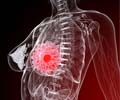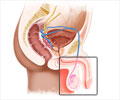The test can help in early detection and treatment which is less aggressive and avoid over treatment, leading to fewer toxic effects.

‘MammaPrint tests for a 70-gene signature that can predict whether cancer will recur in early-stage breast cancer patients.’





"This is an important step forward for personalizing care for women with breast cancer," said lead author Laura J. Esserman, MD, MBA, a breast cancer specialist and surgeon with UC Health. "We can now test small node-negative breast cancers, and if they are in the ultralow risk category, we can tell women that they are highly unlikely to die of their cancers and do not need aggressive treatment, including radiation after lumpectomy.
"This is an exciting advance because approximately 20-25 percent of tumors diagnosed today may be ultralow risk," said Esserman, a UCSF professor and director of the UCSF Carol Franc Buck Breast Care Center who also co-leads the breast oncology program at the UCSF Helen Diller Family Comprehensive Cancer Center (HDFCCC).
The medical community for many years has focused on identifying cancer early so that it can be cured or more easily treated. While this can benefit some patients, screening also can detect cancers that are extremely low risk and not life-threatening, which could lead to patients being overtreated.
The issue is compounded because breast cancer can recur many years after diagnosis - for low-grade tumors, the majority of the risk occurs after five years. Until now, tools that could reliably identify ultralow risk tumors at the time of diagnosis have not been available because physicians lacked the assurance that late recurrence could truly be avoided.
Advertisement
In the new study, researchers sought to determine whether a 70-gene test could accurately and reliably identify tumors with indolent, or slow-growing, behavior to assess the risk of cancer recurrence up to 20 years after diagnosis.
Advertisement
In the new analysis, the investigators sought to assess breast cancer patients over 20 years, and to find cancers with no- or almost no-risk for metastatic progression. As such, they collaborated with the Stockholm breast cancer study group (STO), to evaluate patients who have been tracked for decades and were part of a randomized clinical trial of tamoxifen vs no systemic therapy. The STO-3 low-risk trial included 1,780 lymph-node-negative patients with tumors less than or equal to 3 centimeters in diameter, randomized to two years of adjuvant tamoxifen (40 mg. daily) versus no adjuvant treatment. Adjuvant therapy is a treatment provided after the initial surgery or treatment, with the intent to suppress recurrent tumor formation.
All the women had their tumors surgically removed. The researchers used these tissues to profile a total of 652 women, of whom 311 had received tamoxifen, and 339 had not received adjuvant systemic therapy.
The majority of the women (79 percent) had received mastectomies and lymph node removal -- the data did not include cases with less aggressive local therapy. All women had tumors detected in the era prior to the use of screening mammography, so none were detected via mammograph.
The multigene test classified 42 percent of the patients as high-risk, and 58 percent as low-risk. The investigators found that low-risk patients had a 95 percent survival rate at 5 years, but many later died from their disease.
The test classified 15 percent (98) of the cases as ultralow risk, showing that such tumors are an inherent part of the spectrum of breast cancers, even in the era before screening. Not all low-risk tumors were ultralow risk - in fact, only a quarter met the molecular definition. The women with ultralow risk tumors had an excellent prognosis, whether or not they used tamoxifen for two years, said the authors.
"This emphasizes the role that early detection can play, and how we can improve the impact of screening by focusing on those most likely to benefit," said Esserman.
The results suggest that the 70-gene test can be used to help physicians and patients determine their treatment course, and to inform choice of systemic therapy as well as local therapy. In an unscreened population, 15 percent of women will have ultralow risk tumors, said the authors.
With widespread screening, approximately 25 percent of postmenopausal women could have ultralow risk breast cancer that would rarely be associated with recurrence or death, they wrote. For ultralow risk elderly women over age 75 who have other conditions and face a life expectancy of less than a decade, simple excision may be sufficient, they said.
"There are breast cancers that pose little or no systemic risk," said Esserman. "Women who have a tumor that is classified as ultralow risk by 70-gene signature can be reassured that their long-term outcome is expected to be excellent, with or without endocrine therapy. Having a test that accurately identifies a population of women, who have very little risk to begin with, should be welcomed by patients and clinicians alike. These tools will enable doctors to better personalize therapy to safely minimize treatment and reassure women if a cancer is ultralow risk."
Source-Eurekalert















